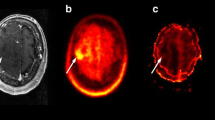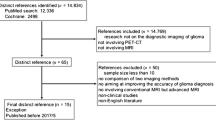Abstract
Purpose
The purpose of this study is to evaluate the diagnostic concordance and metric correlations of amide proton transfer (APT) imaging with gadolinium-enhanced magnetic resonance imaging (MRI) and 2-deoxy-2-[18F-]fluoro-D-glucose ([18F]FDG) positron emission tomography (PET), using hybrid brain PET/MRI.
Procedures
Twenty-one subjects underwent brain gadolinium-enhanced [18F]FDG PET/MRI prospectively. Imaging accuracy was compared between unenhanced MRI, MRI with enhancement, APT-weighted (APTW) images, and PET based on six diagnostic criteria. Among tumors, the McNemar test was further used for concordance assessment between gadolinium-enhanced imaging, APT imaging, and [18F]FDG PET. As well, the relation of metrics between APT imaging and PET was analyzed by the Pearson correlation analysis.
Results
APT imaging and gadolinium-enhanced MRI showed superior and similar diagnostic accuracy. APTW signal intensity and gadolinium enhancement were concordant in 19 tumors (100 %), while high [18F]FDG avidity was shown in only 12 (63.2 %). For the metrics from APT imaging and PET, there was significant correlation for 13 hypermetabolic tumors (P < 0.05) and no correlation for the remaining six [18F]FDG-avid tumors.
Conclusions
APT imaging can be used to increase diagnostic accuracy with no need to administer gadolinium chelates. APT imaging may provide an added value to [18F]FDG PET in the evaluation of tumor metabolic activity during brain PET/MR studies.




Similar content being viewed by others
References
Fraum TJ, Fowler KJ, McConathy J (2016) PET/MRI:: emerging clinical applications in oncology. Acad Radiol 23:220–236
Spick C, Herrmann K, Czernin J (2016) 18F-FDG PET/CT and PET/MRI perform equally well in cancer patients: evidence from studies on more than 2300 patients. J Nucl Med 57:420–430
Ishii S, Shimao D, Hara T et al (2016) Comparison of integrated whole-body PET/MR and PET/CT: is PET/MR alternative to PET/CT in routine clinical oncology? Ann Nucl Med 30:225–233
Padhani AR, Liu G, Mu-Koh D et al (2009) Diffusion-weighted magnetic resonance imaging as a cancer biomarker: consensus and recommendations. Neoplasia 11:102–125
Yang D, Korogi Y, Sugahara T et al (2002) Cerebral gliomas: prospective comparison of multivoxel 2D chemical-shift imaging proton MR spectroscopy, echoplanar perfusion and diffusion-weighted MRI. Neuroradiology 44:656–666
Zhou J, Payen JF, Wilson DA, Traystman RJ, van Zijl PC (2003) Using the amide proton signals of intracellular proteins and peptides to detect pH effects in MRI. Nat Med 9:1085–1090
Li C, Peng S, Wang R et al (2014) Chemical exchange saturation transfer MR imaging of Parkinson’s disease at 3 Tesla. Eur Radiol 24:2631–2639
Harston GW, Tee YK, Blockley N et al (2015) Identifying the ischaemic penumbra using pH-weighted magnetic resonance imaging. Brain 138:36–42
Sun H, Xin J, Zhang S et al (2014) Anatomical and functional volume concordance between FDG PET, and T2 and diffusion-weighted MRI for cervical cancer: a hybrid PET/MR study. Eur J Nucl Med Mol Imaging 41:898–905
Han M, Kim SY, Lee SJ, Choi JW (2015) The correlations between MRI perfusion, diffusion parameters, and 18F-FDG PET metabolic parameters in primary head-and-neck cancer: a cross-sectional analysis in single institute. Medicine (Baltimore) 94:e2141
Zhou J, Blakeley JO, Hua J et al (2008) Practical data acquisition method for human brain tumor amide proton transfer (APT) imaging. Magn Reson Med 60:842–849
Jiang S, Yu H, Wang X et al (2016) Molecular MRI differentiation between primary central nervous system lymphomas and high-grade gliomas using endogenous protein-based amide proton transfer MR imaging at 3 Tesla. Eur Radiol 26:64–71
Kickingereder P, Wiestler B, Sahm F et al (2014) Primary central nervous system lymphoma and atypical glioblastoma: multiparametric differentiation by using diffusion-, perfusion-, and susceptibility-weighted MR imaging. Radiology 272:843–850
Padma MV, Said S, Jacobs M et al (2003) Prediction of pathology and survival by FDG PET in gliomas. J Neuro-Oncol 64:227–237
Klenk C, Gawande R, Tran VT et al (2016) Progressing toward a cohesive pediatric 18F-FDG PET/MR protocol: is administration of gadolinium chelates necessary? J Nucl Med 57:70–77
Goerke S, Zaiss M, Kunz P et al (2015) Signature of protein unfolding in chemical exchange saturation transfer imaging. NMR Biomed 28:906–913
Zhou J, Lal B, Wilson DA, Laterra J, van Zijl PC (2003) Amide proton transfer (APT) contrast for imaging of brain tumors. Magn Reson Med 50:1120–1126
Jones CK, Schlosser MJ, van Zijl PC et al (2006) Amide proton transfer imaging of human brain tumors at 3T. Magn Reson Med 56:585–592
Zhou J, Tryggestad E, Wen Z et al (2011) Differentiation between glioma and radiation necrosis using molecular magnetic resonance imaging of endogenous proteins and peptides. Nat Med 17:130–134
Togao O, Yoshiura T, Keupp J et al (2014) Amide proton transfer imaging of adult diffuse gliomas: correlation with histopathological grades. Neuro-Oncology 16:441–448
Park KJ, Kim HS, Park JE et al (2016) Added value of amide proton transfer imaging to conventional and perfusion MR imaging for evaluating the treatment response of newly diagnosed glioblastoma. Eur Radiol 26:4390–4403
Sakata A, Okada T, Yamamoto A et al (2015) Grading glial tumors with amide proton transfer MR imaging: different analytical approaches. J Neuro-Oncol 122:339–348
Ramalho J, Semelka RC, Ramalho M et al (2016) Gadolinium-based contrast agent accumulation and toxicity: an update. AJNR Am J Neuroradiol 37:1192–1198
Thomsen HS, Morcos SK, Almen T et al (2013) Nephrogenic systemic fibrosis and gadolinium-based contrast media: updated ESUR Contrast Medium Safety Committee guidelines. Eur Radiol 23:307–318
Fink JR, Muzi M, Peck M, Krohn KA (2015) Multimodality brain tumor imaging: MR imaging, PET, and PET/MR imaging. J Nucl Med 56:1554–1561
Lee JW, Kang KW, Park SH et al (2009) 18F-FDG PET in the assessment of tumor grade and prediction of tumor recurrence in intracranial meningioma. Eur J Nucl Med Mol Imaging 36:1574–1582
Zhou J, Zhu H, Lim M et al (2013) Three-dimensional amide proton transfer MR imaging of gliomas: initial experience and comparison with gadolinium enhancement. J Magn Reson Imaging 38:1119–1128
Zhu H, Jones CK, van Zijl PC, Barker PB, Zhou J (2010) Fast 3D chemical exchange saturation transfer (CEST) imaging of the human brain. Magn Reson Med 64:638–644
Zhao X, Wen Z, Zhang G et al (2013) Three-dimensional turbo-spin-echo amide proton transfer MR imaging at 3-Tesla and its application to high-grade human brain tumors. Mol Imaging Biol 15:114–122
Wen Z, Hu S, Huang F et al (2010) MR imaging of high-grade brain tumors using endogenous protein and peptide-based contrast. NeuroImage 51:616–622
Walker-Samuel S, Ramasawmy R, Torrealdea F et al (2013) In vivo imaging of glucose uptake and metabolism in tumors. Nature Med 19:1067–1072
Rivlin M, Horev J, Tsarfaty I, Navon G (2013) Molecular imaging of tumors and metastases using chemical exchange saturation transfer (CEST) MRI. Sci Rep 3:3045
Acknowledgments
The authors thank Ms. Mary McAllister for her professional editorial assistance.
Funding
This work was supported in part by grants from the National Natural Science Foundation of China (Grant No. 81401438) and from the National Institutes of Health (R01EB009731, R01CA166171, R01NS083435).
Author information
Authors and Affiliations
Corresponding author
Ethics declarations
No complex statistical methods were necessary for this paper. Institutional review board approval was obtained. Written informed consent was obtained from all subjects (patients) in this study. Methodology: retrospective, diagnostic or prognostic study, performed at one institution.
Conflict of Interest
The authors declare that they have no conflict of interest.
Rights and permissions
About this article
Cite this article
Sun, H., Xin, J., Zhou, J. et al. Applying Amide Proton Transfer MR Imaging to Hybrid Brain PET/MR: Concordance with Gadolinium Enhancement and Added Value to [18F]FDG PET. Mol Imaging Biol 20, 473–481 (2018). https://doi.org/10.1007/s11307-017-1136-0
Published:
Issue Date:
DOI: https://doi.org/10.1007/s11307-017-1136-0




